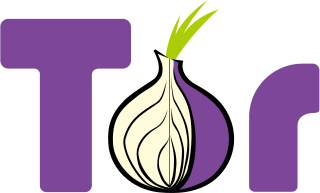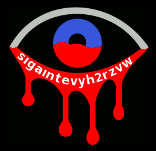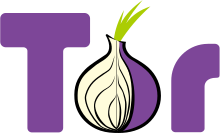
Hypertext Transfer Protocol Secure (HTTPS) is an extension of the Hypertext Transfer Protocol (HTTP). It uses encryption for secure communication over a computer network, and is widely used on the Internet. In HTTPS, the communication protocol is encrypted using Transport Layer Security (TLS) or, formerly, Secure Sockets Layer (SSL). The protocol is therefore also referred to as HTTP over TLS, or HTTP over SSL.

In computer networking, a proxy server is a server application that acts as an intermediary between a client requesting a resource and the server providing that resource. It improves privacy, security, and performance in the process.
In cryptography, a certificate authority or certification authority (CA) is an entity that stores, signs, and issues digital certificates. A digital certificate certifies the ownership of a public key by the named subject of the certificate. This allows others to rely upon signatures or on assertions made about the private key that corresponds to the certified public key. A CA acts as a trusted third party—trusted both by the subject (owner) of the certificate and by the party relying upon the certificate. The format of these certificates is specified by the X.509 or EMV standard.

Onion routing is a technique for anonymous communication over a computer network. In an onion network, messages are encapsulated in layers of encryption, analogous to the layers of an onion. The encrypted data is transmitted through a series of network nodes called "onion routers," each of which "peels" away a single layer, revealing the data's next destination. When the final layer is decrypted, the message arrives at its destination. The sender remains anonymous because each intermediary knows only the location of the immediately preceding and following nodes. While onion routing provides a high level of security and anonymity, there are methods to break the anonymity of this technique, such as timing analysis.
Xcitium, formerly known as Comodo Security Solutions, Inc., is a cybersecurity company headquartered in Bloomfield, New Jersey. Under the brand Sectigo, the company acts as a web Certificate authority (CA) and issues SSL/TLS certificates to secure the web infrastructure.
Code signing is the process of digitally signing executables and scripts to confirm the software author and guarantee that the code has not been altered or corrupted since it was signed. The process employs the use of a cryptographic hash to validate authenticity and integrity. Code signing was invented in 1995 by Michael Doyle, as part of the Eolas WebWish browser plug-in, which enabled the use of public-key cryptography to sign downloadable Web app program code using a secret key, so the plug-in code interpreter could then use the corresponding public key to authenticate the code before allowing it access to the code interpreter's APIs.

An Extended Validation Certificate (EV) is a certificate conforming to X.509 that proves the legal entity of the owner and is signed by a certificate authority key that can issue EV certificates. EV certificates can be used in the same manner as any other X.509 certificates, including securing web communications with HTTPS and signing software and documents. Unlike domain-validated certificates and organization-validation certificates, EV certificates can be issued only by a subset of certificate authorities (CAs) and require verification of the requesting entity's legal identity before certificate issuance.
An anonymizer or an anonymous proxy is a tool that attempts to make activity on the Internet untraceable. It is a proxy server computer that acts as an intermediary and privacy shield between a client computer and the rest of the Internet. It accesses the Internet on the user's behalf, protecting personal information of the user by hiding the client computer's identifying information such as IP addresses. Anonymous proxy is the opposite of transparent proxy, which sends user information in the connection request header. Commercial anonymous proxies are usually sold as VPN services.
Server Name Indication (SNI) is an extension to the Transport Layer Security (TLS) computer networking protocol by which a client indicates which hostname it is attempting to connect to at the start of the handshaking process. The extension allows a server to present one of multiple possible certificates on the same IP address and TCP port number and hence allows multiple secure (HTTPS) websites to be served by the same IP address without requiring all those sites to use the same certificate. It is the conceptual equivalent to HTTP/1.1 name-based virtual hosting, but for HTTPS. This also allows a proxy to forward client traffic to the right server during TLS/SSL handshake. The desired hostname is not encrypted in the original SNI extension, so an eavesdropper can see which site is being requested. The SNI extension was specified in 2003 in RFC 3546

Tor is a free overlay network for enabling anonymous communication. Built on free and open-source software and more than seven thousand volunteer-operated relays worldwide, users can have their Internet traffic routed via a random path through the network.
The Certification Authority Browser Forum, also known as the CA/Browser Forum, is a voluntary consortium of certification authorities, vendors of Internet browser and secure email software, operating systems, and other PKI-enabled applications that promulgates industry guidelines governing the issuance and management of X.509 v.3 digital certificates that chain to a trust anchor embedded in such applications. Its guidelines cover certificates used for the SSL/TLS protocol and code signing, as well as system and network security of certificate authorities.
Internet censorship circumvention, also referred to as going over the wall or scientific browsing in China, is the use of various methods and tools to bypass internet censorship.
Flash proxy is a pluggable transport and proxy which runs in a web browser. Flash proxies are an Internet censorship circumvention tool which enables users to connect to the Tor anonymity network via a plethora of ephemeral browser-based proxy relays. The essential idea is that the IP addresses contingently used are changed faster than a censoring agency can detect, track, and block them. The Tor traffic is wrapped in a WebSocket format and disguised with an XOR cipher.

Alec David Edward Muffett is an Anglo-American internet security expert and software engineer. His work includes Crack, the original password cracker for Unix, and for the CrackLib password-integrity testing library. He is active in the open-source software community.

Tor2web is a software project to allow Tor hidden services to be accessed from a standard browser without being connected to the Tor network. It was created by Aaron Swartz and Virgil Griffith.
.tor is a pseudo-top-level domain host suffix implemented by the OnioNS project, which aims to add DNS infrastructure to the Tor network enabling the selection of meaningful and globally-unique domain name for hidden services, which users can then reference from the Tor Browser.
The Facebook onion address located at facebookwkhpilnemxj7asaniu7vnjjbiltxjqhye3mhbshg7kx5tfyd.onion is a site that allows access to Facebook through the Tor protocol, using its .onion top-level domain.

SIGAINT was a Tor hidden service offering secure email services. According to its FAQ page, its web interface used SquirrelMail which does not rely on JavaScript. Passwords couldn't be recovered. Users received two addresses per inbox: one at sigaint.org for receiving clearnet emails and the other at its .onion address only for receiving emails sent from other Tor-enabled email services. Free accounts had 50 MB of storage space and expired after one year of inactivity. Upgraded accounts had access to POP3, IMAP, SMTP, larger size limits, full disk encryption, and never expired.

Snowflake is a software package for assisting others in circumventing internet censorship by relaying data requests. Snowflake relay nodes are meant to be created by people in countries where Tor and Snowflake are not blocked. People under censorship then use a Snowflake client, packaged with the Tor Browser or Onion Browser, to access the Tor network, using Snowflake relays as proxy servers. Access to the Tor network can in turn give access to other blocked services. A Snowflake node can be created by either installing a browser extension, installing a stand-alone program, or browsing a webpage with an embedded Snowflake relay. The node runs whenever the browser or program is connected to the internet.









